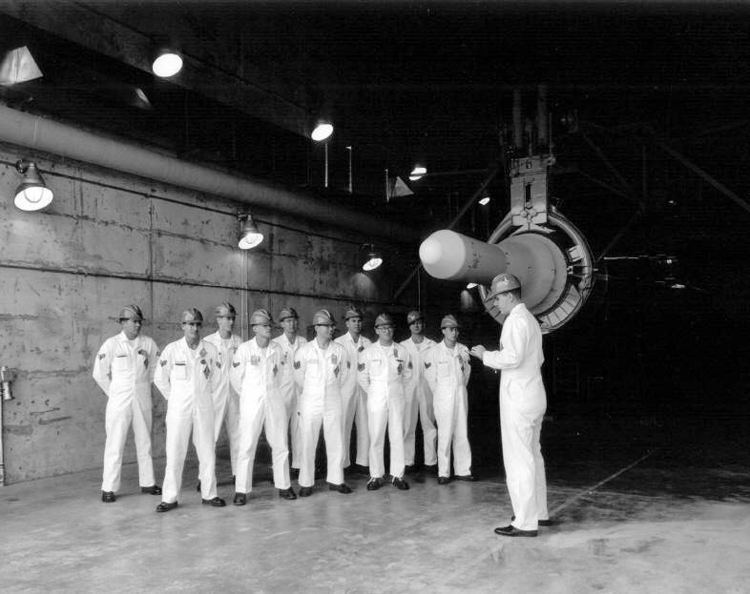Active 1943-1965 Type Squadron | ||
 | ||
Garrison/HQ F. E. Warren AFB, Wyoming | ||
The 565th Strategic Missile Squadron (565 SMS) is an inactive United States Air Force unit. It was last assigned to the 389th Strategic Missile Wing, stationed at F. E. Warren AFB, Wyoming.
Contents
- World War II
- Intercontinental Ballistic Missile Squadron
- Lineage
- Assignments
- Aircraft and missiles
- References
On 15 August 1959, the 565th Strategic Missile Squadron (ICBM-Atlas) was the second Strategic Air Command (SAC) Intercontinental ballistic missile (ICBM) squadron to go on operational alert status, being equipped with the first-generation SM-65D Atlas, with a mission of nuclear deterrence.
The squadron was inactivated as part of the phaseout of the Atlas ICBM on 25 March 1965.
World War II
Activated as a B-24 Liberator heavy bombardment squadron in December 1942; assigned to II Bomber Command for training. Primarily trained in Texas and Colorado. Received deployment orders for the European Theater of Operations (ETO) in April 1943.
Deployed to England in May 1943, being assigned to the VIII Bomber Command and stationed at RAF Hethel. Upon its arrival at Hethel, almost was sent to Libya, where it began operations on July 9, 1943. The detachment flew missions to Crete, Sicily, Italy, Austria, and Romania. Received a Distinguished Unit Citation for the detachment's participation in the famed low-level attack against oil refineries at Ploesti on August 1, 1943. Returned to England in August and the squadron flew several missions against airfields in France and the Netherlands.
The squadron deployed again temporarily to Tunisia during September and October 1943 with the group supporting Allied operations at Salerno and hit targets in Corsica, Italy, and Austria.
Resumed operations from RAF Hethel in October 1943 the squadron engaged in very long range strategic bombardment operations over Occupied Europe and Nazi Germany. Targets included industrial facilities; oil production facilities and refineries, rail and other transportation centers, enemy military airfields and garrisons. The squadron participated in the intensive air campaign against the German aircraft industry during Big Week, February 20–25, 1944.
Continued attacks on enemy targets until the German Capitulation in May 1945; returning to the United States later that month and reforming at Charleston Army Airfield, South Carolina. Unit personnel were demobilized throughout the summer of 1945. Inactivated on 13 September 1945.
Effective 15 September 1947, the squadron was activated at Fairfax Field, Kansas. Having been allotted to the organized reserves, with assignment to Second Air Force, Air Defense Command, it was redesigned as a very heavy bombardment unit on 25 August. In July 1948, the squadron was assigned to the Tenth Air Force, which in December, became a part of the Continental Air Command. The squadron was inactivated on 27 June 1949 due to budget restrictions.
Intercontinental Ballistic Missile Squadron
Reactivated in 1959 as a Strategic Air Command SM-65D Atlas ICBM launch squadron, stationed at FE Warren AFB, Wyoming and assigned to the 706th Strategic Missile Wing. The 706th SMW was the first United States Air Force ICBM wing to be activated. The 565th was programmed for the above-ground Atlas D ICBM launch and control facilities. After construction delays, the squadron became the second ICBM squadron to go on operational alert on 2 September 1960.
The squadron was assigned nine missiles, based in a 3 x 3 configuration: three launchers and one combined guidance control/launch facility constituted a launch complex, and three dispersed complex locations comprised the squadron.
The missiles were housed in a "coffin launcher" style complexes. The missile was kept in semi-hard facilities in which the missile was stored above ground horizontally above ground. In order to launch, a 400-ton overhead door was rolled back after which the "bird" was raised to a vertical position. Once upright, the rocket was fueled with RP-1 and Liquid Oxygen after which it would then be made ready for launch. (see below for site details).
Missiles were retired and removed in September 1964 in favor of the more advanced LGM-25C Titan II; squadron was inactivated on 25 March 1965. Missile sites were later sold off to private ownership after demilitarization.
